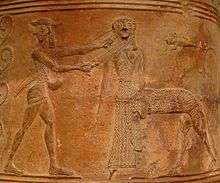Talaria
The Talaria of Mercury (Latin: tālāria or The Winged Sandals of Hermes Ancient Greek: πτηνοπέδῑλος, ptēnopédilos or πτερόεντα πέδιλα, pteróenta pédila) are winged sandals, a symbol of the Greek messenger god Hermes (Roman equivalent Mercury). They were said to be made by the god Hephaestus of imperishable gold and they flew the god as swift as any bird.

Etymology
The Latin noun tālāria, neuter plural of tālāris signifies "of the ankle". It is not quite certain how the Romans arrived at the meaning of "winged sandals" from this, possibly that the wings were attached at the ankles, or the sandals were tied around the ankles.[2]
Attestations
In ancient Greek literature, the sandals of Hermes are first of all mentioned by Homer (ἀμβρόσια χρύσεια; ambrósia khrýseia, "immortal/divine and of gold"), though not described as "winged".[3][2][4]
The description of the sandals being winged first appear in the poem Shield of Heracles (c. 600–550 B.C.), which speaks of πτερόεντα πέδιλα (pteróenta pédila), literally "winged sandals".[2][5] The Homeric hymn to Hermes from a somewhat later date (520 B.C.) does not explicitly state the sandals were winged, though they allowed him to leave no footprints while committing his theft of Apollo's cattle.[4]
According to one estimation, it was around 5th century B. C. when the winged sandals came to be regarded as common (though not indispensable) accouterments of the god Hermes.[2] One later instance which refers to the sandals being winged is the Orphic Hymns XXVIII to Hermes (3c. B.C.–2c. C.E.).[6][4]
Perseus wears Hermes' sandals to help him slay Medusa.[7] According to Aeschylus, Hermes gives them to him directly.[8] In a better-attested version, Perseus must retrieve them from the Graeae, along with the cap of invisibility and the kibisis (sack).[9]
Latin sources
The term talaria has been employed by Ovid in the 1st century, and prior to him, in perhaps 8 instances by various Latin authors (Cicero, Virgil, etc.).[10] The term is usually construed as "winged sandals", and applied almost exclusively to the footwear worn by the god Hermes/Mercury or the hero Perseus.[11]
Medieval interpretation
In the case of the talaria worn by the swift runner Atalanta (Ovid, Metamorphoses X.591) some translators in the past steered away from recognizing them as footwear, and chose to regard them as "long robes", starting with Planudes in the 14th century. This interpretation was also endorsed in the 17th century by Nicolaas Heinsius's gloss, and persisted in the 19th century with Lewis and Short's dictionary entry for this particular passage.[12] But there are "insuperable" reasons against this "robes" interpretation, for Ovid clearly states in the forgoing passages that Atalanta had disrobed[lower-alpha 1] to engage in the foot-race.[13][lower-alpha 2]
Also in the medieval Irish versions of the Aeneid (Imtheachta Aeniasa) and the Destruction of Troy (Togail Troí), Mercury wears a "bird covering" or "feather mantle" (Old Irish: encennach, énchendach), which clearly derives from Mercury's talaria, such as described by Virgil.[14][15][lower-alpha 3]
In popular culture
In Rick Riordan's Percy Jackson & the Olympians series, the Talaria is a pair of sneakers worn by Grover Underwood.[16]
In God of War III, Kratos forcibly takes the Boots of Hermes off the Messenger God's feet by cutting his legs off.
See also
- EADS Talarion an unmanned air vehicle named after Talaria.
Explanatory notes
- Latin: posito velamine
- However, the reading Atalanta as racing naked (as Anderson insists) is rejected in favor of a more "modest interpretation" by certain translators (F. Bernini 1943, T. Morino 1946), who perceive Atalanta as still clothed (in talaraia), which were seen to have "moved" (Italian: mossa) or were "tossed aside" (Italian: gettata via by her fast-moving feet.[13]
- Whitley Stokes (1881) pointed to the parallel to the fjaðrhamr (feather cloak) of Old Norse texts.[14]
References
- Citations
- Gantz, 541.
- Anderson (1966), p. 8.
- Homer, Odyssey, V, 44.
- Freedman (2014–2015), pp. 190–191.
- Pseudo-Hesiod, Shield of Heracles, 220.
- Orphic Hymn 28, v. 4
- Gaius Julius Hyginus, Fables (LXIV) and Nonnus, Dionysiaca, (XIV, 270).
- Aeschylus, The Phorkides, fr. 262 iv, v Radt.
- Pherecydes, 3F11 Fragmente der griechischen Historiker, and the Bibliotheca (Pseudo-Apollodorus), II, 4, 2.
- Anderson (1966), p. 7.
- Anderson (1966), p. 5.
- Anderson (1966), pp. 1–2.
- Anderson (1966), pp. 2–3.
- Miles, Brent (2011). Heroic Saga and Classical Epic in Medieval Ireland. The Concept of the Goddess. Cambridge: DS Brewer. pp. 75–76. ISBN 1843842645. ISSN 0261-9865.CS1 maint: ref=harv (link)
- eDIL, s.v. "énchendach". "bird-covering, feather mantle.. [but] in the following exx. the meaning seems transferred, wings, feathers; a winged thing.. rogab [Mercuir] a enceandaigh uime...┐ gabaid a luirg n-encheandaighi ina laim (i.e. the talaria and caduceus), Aen.[Imtheachta Aeniasa] 766–7 .. encennach Mercúir, cumma imthéit muir ┐ tír, LL 220 b26 = TTr. [Togail Troi] 258 ."
- Riordan, Rick (July 1, 2005). The Lightning Thief. United States Of America: Puffin Books Disney-Hyperion. ISBN 0-7868-5629-7.
- Bibliography
- Anderson, William S. (1966). "Talaria and Ovid Met. 10.591". Transactions and Proceedings of the American Philological Association. 97: 1–13. JSTOR 2935997.
- Freedman, Luba (2014–2015), "'Argicida Mercurius' from Homer to Giraldi and from Greek Vases to Sansovino", Memoirs of the American Academy in Rome 2014/2015, University of Michigan Press for the American Academy in Rome, 59/60, pp. 181–254, JSTOR 44981977
- Gantz, Timothy (2004). Mythes de la Grèce archaïque, Berlin. pp. 541-543.
External links

